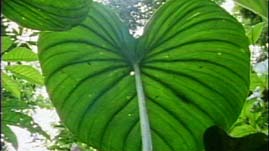Teachers' Domain - Digital Media for the Classroom and Professional Development
User: Preview

Source: Interactive NOVA: "Earth"
This video segment from Interactive NOVA: "Earth" explores the history of plant biology. It takes the viewer from the earliest scientific hypotheses that plants ate dirt, to our present-day understanding of photosynthesis, the process by which plants use the sun's energy to convert carbon dioxide and water into carbohydrates, a storable form of chemical energy.
Photosynthesis (Audio Description) (Video)
It's not surprising that early scientists hypothesized that plants ate dirt. They didn't know, as we now do, how energy-rich sunlight is. Still, it seems remarkable that plants have evolved photosynthesis--the ability to harness the sun's energy to produce their own food.
Photosynthesis is the process by which plants transform water and carbon dioxide (a gas that's plentiful in the air) into carbohydrates (sugars and starches), using the energy of sunlight. While sunlight provides the energy needed to drive this reaction, a chemical in the leaves of plants makes the reaction possible. That chemical is a green pigment called chlorophyll. Chlorophyll is found inside the photosynthetic cells of plants, attached to the membranes of small, round structures called chloroplasts. Chlorophyll absorbs light in the red and blue-violet portions of the visible spectrum, and reflects the green portion of the spectrum; this is what gives chlorophyll its characteristic green color.
As remarkable as photosynthesis is, the process is not very efficient. Studies show that prairie grasses in the western United States are some of the most efficient plants at harnessing the sun's energy, but even they capture little more than about 3 percent of the energy that reaches the prairie surface. The rest of that energy is reflected away, absorbed by humidity in the air or by the ground, or simply lost in myriad other ways before the plants can use it.
One of the most critical factors influencing the efficiency of photosynthesis is the amount (intensity and duration) of light that hits a leaf. Generally, the more light that strikes a leaf, the greater the rate of photosynthesis in that leaf. For example, a leaf that is exposed to direct sunlight will photosynthesize at the highest rate, while a leaf directly beneath it and in its shadow will photosynthesize at a much lower rate. Because of this, many plants have evolved leaf and branch structures that minimize overlap and shading, and thus maximize the plant's overall rate of photosynthesis.
NARRATOR: All life must have nourishment to live and grow. It's usually easy to tell where an animal's nourishment comes from. But what do plants eat?
Simply watching a plant won't give you the answer. They don't have mouths. Because plants grow up from the ground, people used to think plants ate soil for nourishment.
In the early 1600s, a Belgian scientist, Jan Baptist van Helmont, set out to discover for himself if this was true. Helmont planted a small willow branch into a pot of soil that weighed 200 pounds. For two years, he gave his tree only water. It gained 164 pounds. The soil, however, lost less than a pound.
The experiment convinced Helmont that plants get their nourishment from water, not soil. And he was partly right.
We now know that plants don't eat food the way animals do. They make food inside their cells. It happens in these tiny green bodies called chloroplasts in a process called photosynthesis. Photosynthesis is the source of all our food and all our oxygen.
A chloroplast is like a tiny factory. As Helmont saw, one of the key raw materials is water. But he couldn't see the other raw material, an invisible gas in the air called carbon dioxide. The chloroplast uses the energy in sunlight to combine the carbon dioxide and the water into a kind of sugar, called glucose. The sun's energy is stored in the glucose.
The reaction also makes oxygen, which is released into the atmosphere. The plant uses the sugar's energy to make all the other materials it needs to grow. By eating the plant, we can take a bite of all that stored solar energy and use it to power our own lives.
 Loading Standards
Loading Standards Teachers' Domain is proud to be a Pathways portal to the National Science Digital Library.
Teachers' Domain is proud to be a Pathways portal to the National Science Digital Library.
